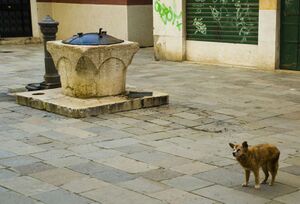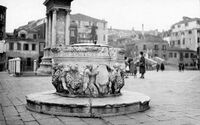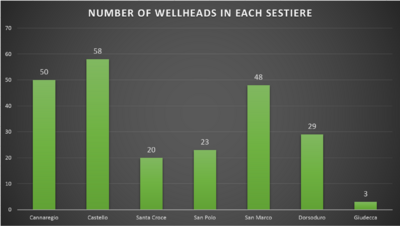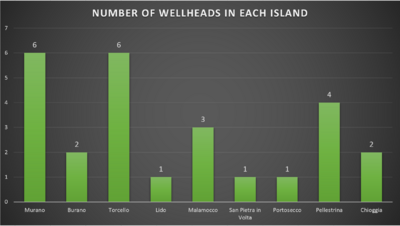Wellheads
This page is an overview of all the wellheads in Venice.
There are 231 public wellheads located in the various squares of the city of Venice and 26 located in the surrounding islands of the lagoon. The wellheads on Venice proper are divided by sestiere, or district. Venice proper is divided into seven sestieri and the figure below depicts the general distribution of the public wellheads.
Cultural Importance

While Wellheads are no longer in use, they still hold cultural and historical significance to the city. Wellheads were built with a main purpose of protecting Venice's fresh water supply from possible sources of contamination, but how they were built and designed exemplified the city’s culture and its love for art. Often, wellheads were festooned with carvings of saints, family crests, inscriptions, or other images important to Venetians; carvings of saints usually faced the nearest church. The design and decorative characteristics of wellheads vary depending on the time period in which they were built; Carolingian, Byzantine, Gothic, Renaissance, and Baroque eras are all associated with different wellhead designs.[1].
In order to preserve the artistic features of the wellheads, the material with which they were built is also important. Most wellheads in the early centuries were built with bricks. Brick, however, crumbles and deteriorates quickly so that nearly all wellheads in Venice that were made of brick are now gone. Most of the remaining wellheads in Venice today are made of stone. There are three main types of stone material that wellheads are made of: Istria stone, Red Verona marble and White verona marble. All but three of the 241 public wellheads cataloged are composed exclusively of Istria stone, Red Verona marble, or White Verona marble. One of these three is a mixture of Red Verona and Istria stone. Istria stone, the most common material, accounts for 79 percent of the wellheads cataloged. Istria is followed by 13.4 percent Red Verona marble, 6.7 percent White Verona marble and 0.9 percent other.
Since wells are no longer used as a source of water and now only serve as displays of public art, the city decided to replace the lids, using more durable materials such as metal, concrete and sometimes stone and wood. By doing so, most wellheads were permanently closed off or may only be opened for maintenance purposes. Some of these lids have been modeled after their predecessors; boasting hinges and handles, despite their lack of practical function. Some lids even serve as works of art themselves, including one found in Chioggia with a bronze statue serving as the lid.
In the past, these wellheads served as access points to fresh water for not only the human population of Venice, but the animals as well. Small, bowl-shaped indentations were made in the platforms of some wellheads. These indentations served as a source of fresh drinking water and as baths for the local wild life.
Alberto Rizzi
Alberto Rizzi has made great efforts in the field of art preservation in Venice, and is the author of the book Vere da Pozzo di Venezi. Alberto has cataloged and assigned identification numbers known as Rizzi Numbers to each of the individual wellheads in Venice. In this book, 231 public wellheads in the sestieri of Venice are cataloged. (50 in Cannaregio, 58 in Castello, 20 in Santa Croce, 23 in San Polo, 48 in San Marco, 29 in Dorsoduro, and 3 in Giudecca)[2]. In addition to those in Venice, 26 public wellheads are located on the lagoon islands of Murano, Burano, Torcello, Lido, Malamocco, San Pietro in Volta, Portosecco, Pellestrina, and Chioggia.
While there were originally 231 public wellheads cataloged by Alberto, a recent study completed in 2000 by WPI students shows 217 public wellheads and 15 private wellheads. So 15 wellheads that were originally public have been claimed as private property over the past 30-40 years.
Also catalogued by Alberto Rizzi were the wellheads in the surrounding islands of the lagoon. According to Rizzi there were 6 in Murano, 1 in Burano, 5 in Torcello, 1 in Lido, 3 in Malamocco, 1 in S. Pietro in Volta, 1 in Portosecco, 4 in Pellestrina and 2 in Chioggia. A recent study completed by WPI students in 2014 discovered 2 more wellheads not documented in Rizzi's book in Burano and Torcello (one in each), giving a total of 26 wellheads in the surrounding islands of the lagoon rather than the 24 documented by Alberto Rizzi.
Designs
As public art, these wellheads are given multiple designs:
Statistic
Map
Wellheads are designated by red dots on the map.
See Also
References
Bibliography
NULL





